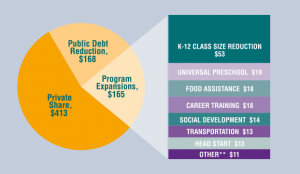Eliminating excessive spending could mean windfall for U.S., study suggests
The respected national Institute of Medicine estimates that $750 billion is lost each year to wasteful or excessive health care spending. This sum includes excess administrative costs, inflated prices, unnecessary services and fraud — dollars that add no value to health and well-being.
If those wasteful costs could be corralled without sacrificing health care quality, how might that money be better spent?
In a study published in the current online edition of the American Journal of Preventive Medicine, Frederick J. Zimmerman, professor and chair of the department of health policy and Management at the UCLA Fielding School of Public Health, and colleagues outline some of the myriad ways that $750 billion could benefit Americans.
“If cut from current health care expenditures, these funds could provide businesses and households with a huge windfall, with enough money left over to fund deficit reduction on the order of the most ambitious plans in Washington,” Zimmerman said. “The money could also cover needed investments in transportation infrastructure, early childhood education, human capital programs, rural development, job retraining programs and much more. And it could transform America with little to no reduction in the quality of, or access to, health care actually provided.”
Zimmerman noted that while different observers would likely have different priorities regarding the alternative uses toward which the wasted expenditures could be directed, all would agree that the alternatives proposed in this study have inherent social value.
“When the fastest-growing part of the economy is also the least efficient, the economy as a whole loses its ability over time to support our current living standards,” said Jonathan Fielding, a UCLA professor of health policy and management and director of the Los Angeles County Department of Public Health, who is a co-author of the study. “The U.S. has become irrationally attached to its inefficient health care system. Recognizing the opportunity costs of this attachment is the first step in repairing the system.”
In the study, the research group, which also included Dr. Steven Teutsch, chief science officer of the Los Angeles County Department of Public Health, and first author Jeffrey C. McCullough, a graduate student at the UCLA Fielding School, presented one scenario of how that money could be used.
For one, the authors propose that more than $410 billion per year — or 55 percent of the savings — could be returned to the private sector for individuals and companies to use as they please; another $202 billion (27percent) could go toward deficit reduction, yielding a greater reduction than the congressional “super committee” sought and failed to achieve. An additional $104 billion (14 percent) could support additional investments in human capital and physical infrastructure.
“For example,” Zimmerman said, “the Head Start program could be doubled in size, universal preschool could be provided, average class size could be reduced from 22–25 to 13–17 students. And trained nurses could conduct regular home visits for high-risk pregnancies.”
Two percent of the savings, amounting to $18 billion, could promote urban and rural quality of life by improving the built environment surrounding schools, expanding and modernizing public libraries, improving wastewater treatment and providing rural development grants to every small town in the nation. Job-training opportunities would be affordable for nearly 50,000 unemployed persons. And under the research group’s scenario, the remaining 2 percent of the savings would be devoted to fully funding an extensive wish list of transportation projects to alleviate road congestion and promote mass transit alternatives.
Freeing up this money would be no easy task, Fielding warned. These excess expenditures will be difficult to reduce because the costs are spread across many groups, and the financial beneficiaries are coordinated, clear-minded and powerful, he said. Overcoming this resistance will require concerted collective action on the part of many economic sectors, governmental agencies and other organizations that are not used to seeing themselves as sharing interests with the others.
But whatever one’s values and preferences, said Zimmerman, “eliminating excess medical care costs provides a monumental opportunity to reallocate those resources to strengthen our international competitiveness, enhance our well-being and build a healthier nation.”
The result of redirecting some $750 billion per year, he said, could be transformative for Americans, and the potential uses for these funds are panoramic in both scope and possibility.
“This will not be an easy fight,” Zimmerman said. “But we believe reconceptualizing our excess health care spending by looking at its opportunity cost to society is an important first step.”
A video of the group’s research is available online at www.ajpmonline.org/content/video_pubcasts_collection.
This research was not supported by external grants or funding. The authors report no conflict of interest.
– By Mark Wheeler
*Source: University of California



